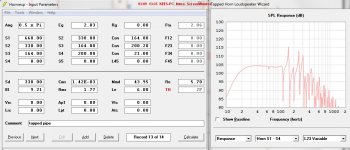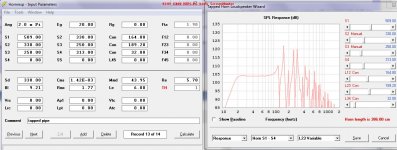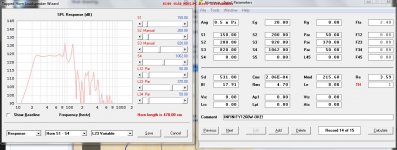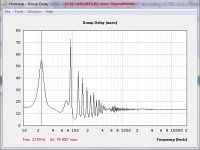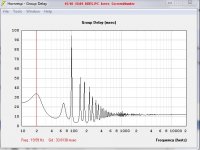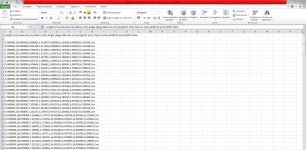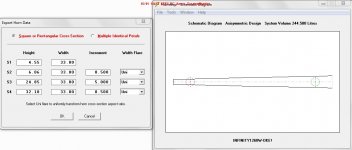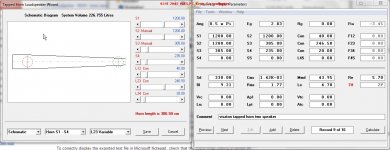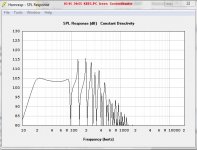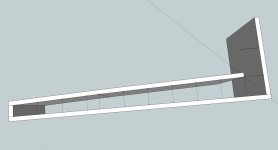It's a tapped TL same as the early '50s Jensen Transflex.
GM
If I go to internet and search about old bass systems it looks that high efficienty systems are easy when use not more then a couple octaves of output, and so a speaker system with low bass into balls has to be a 3 way 18-60-60and up.
The air coupler is a organ pipe, it looks also like that, organ pipes however is tuned to one frequentie and the invention here wih a speaker is to vary the opening on the expense of efficienty and more widh bandwith, just fun to see that not only electronics have this but also air.
Why is a T-QWT better then a tapped horn? why I don,t need EQ and fase correction with it, and why it is needed with a tapped horn, I did see a tapped horn has a wild fase reaction, T-QWT is a inverted tapped horn damping the wildness in it.
regards
I did some test with the visatons, one speaker.
looks nice but spl per watt is 85 dB, I can go wide, above 100 Hz
without wildness.
The TS parameters of the infinity are oke, I have test it with martin sheet, I do not use this woofer for TQWT because it don,t work there well, it is for tapped horn, in the lab 12 it works with slight changes.
The TQWT do react strongly at corner load or not, (peak at 70 Hz) but that is manageble with damping I think?
looks nice but spl per watt is 85 dB, I can go wide, above 100 Hz
without wildness.
The TS parameters of the infinity are oke, I have test it with martin sheet, I do not use this woofer for TQWT because it don,t work there well, it is for tapped horn, in the lab 12 it works with slight changes.
The TQWT do react strongly at corner load or not, (peak at 70 Hz) but that is manageble with damping I think?
Attachments
Wel it is a tapped horn thread so, I shere the hornresp data for the infinity W1260 woofer, the graph looks good, in a TQWT this woofer don,t work and a tapped pipe also not good, I have him and so a tapped horn wil it be, I have shorted the horn length to 25 hz and then still I have 118 dB on 20 hz so I can hear an pipe organ lowest octave, nice, the visatons do wel in a tapped pipe or TQWT, so a light cone is good there.
So much boxes, difficult to decide what, it is for home theatre use and music.
have a nive weekend, here, the winter do a attack again, monday again minus 7 .
So much boxes, difficult to decide what, it is for home theatre use and music.
have a nive weekend, here, the winter do a attack again, monday again minus 7 .
Attachments
Why is a T-QWT better then a tapped horn? why I don,t need EQ and fase correction with it, and why it is needed with a tapped horn, I did see a tapped horn has a wild fase reaction, T-QWT is a inverted tapped horn damping the wildness in it.
regards
It can be tuned over a wider BW.
Hmm, when comparing 'apples to apples', an end loaded TH has a better overall phase response than a TTQWT according to HR, but a worse group delay, so depending on how sensitive you are to the latter seems the main concern here. That, and the TH will be much larger, though of course several dB more efficient.
While I've not heard anything in auditioning Danley's THs to make me biased against THs, I've yet to build/measure either type yet, so do a search of bjorno's posts as he has elaborated on this subject before.
GM
I have seen that the TQWT is in fact a reversed tapped horn and so you gain bandwith at expense of efficienty but for home use it is enough, for PA a tapped horn is better, see I this right, I also go look and read about it, the infinity wil not work in it, I did try, possible to heavy cone weight..
in the pictures I did see a group delay of 80 milliseconds for Tapped Horn and 20 millisecond for the tapped pipe so the tapped horn indeed has a lot more, the most delay was around the cutoff 20-23 Hz I don,t now if it has impact then op sound.
I have a hydrid amp (mosfet/tubes) and not a single bass amp I have to use analog filtering for delay.
Hornresp can export a txt file for use on folding but here it exports a txt file who is a little a mess not beautifull colums so I can read it easely, further hornresp ask for update every time unwhile i have the last version.
in the pictures I did see a group delay of 80 milliseconds for Tapped Horn and 20 millisecond for the tapped pipe so the tapped horn indeed has a lot more, the most delay was around the cutoff 20-23 Hz I don,t now if it has impact then op sound.
I have a hydrid amp (mosfet/tubes) and not a single bass amp I have to use analog filtering for delay.
Hornresp can export a txt file for use on folding but here it exports a txt file who is a little a mess not beautifull colums so I can read it easely, further hornresp ask for update every time unwhile i have the last version.
Attachments
Last edited:
A last question, how with T-TQWT start for example speaker Sd start and end how much is needed?
And here delay and crossover things, http://www.bssaudio.com/product_downloads/App_Notes/Crossovers_Demysified.pdf
But I think analog fase shifting this big is a problem and I do not like digital things in my system except the cd player, I have to move
the tapped horn or T_TQWT for correction, the most delay is around 22 hz so not a big issiue.
thanks and now I good read this very big thread to learn some about you guys.
And here delay and crossover things, http://www.bssaudio.com/product_downloads/App_Notes/Crossovers_Demysified.pdf
But I think analog fase shifting this big is a problem and I do not like digital things in my system except the cd player, I have to move
the tapped horn or T_TQWT for correction, the most delay is around 22 hz so not a big issiue.
thanks and now I good read this very big thread to learn some about you guys.
Last edited:
Hi kees52,
To correctly display the exported text file in Microsoft Word you may need to change to a fixed-width font (for example Courier New), reduce the font size, and decrease the left and right margins.
To correctly display the exported text file in Microsoft Notepad, check that the Word Wrap setting is turned off.
Alternatively the file can be exported in csv format and directly opened in Microsoft Excel.
You will find that even though the version number may be the same, the product number will have changed (to indicate a new release).
Kind regards,
David
Hornresp can export a txt file for use on folding but here it exports a txt file who is a little a mess not beautifull colums so I can read it easely,
To correctly display the exported text file in Microsoft Word you may need to change to a fixed-width font (for example Courier New), reduce the font size, and decrease the left and right margins.
To correctly display the exported text file in Microsoft Notepad, check that the Word Wrap setting is turned off.
Alternatively the file can be exported in csv format and directly opened in Microsoft Excel.
hornresp ask for update every time unwhile i have the last version.
You will find that even though the version number may be the same, the product number will have changed (to indicate a new release).
Kind regards,
David
Hi David
I have also try with exel also here a mess see photo
colums on top are longer for example, maybe also here a problem with the fonts?
but for the rest, it is one of the most clever programs ever written. and I now how difficult that is, maybe writing a program who can fold horns like TH TP or TQWT.
Thanks David for this fine piece of software.
I have also try with exel also here a mess see photo
colums on top are longer for example, maybe also here a problem with the fonts?
but for the rest, it is one of the most clever programs ever written. and I now how difficult that is, maybe writing a program who can fold horns like TH TP or TQWT.
Thanks David for this fine piece of software.
Attachments
Hi David
I have also try with exel also here a mess see photo
colums on top are longer for example, maybe also here a problem with the fonts?
but for the rest, it is one of the most clever programs ever written. and I now how difficult that is, maybe writing a program who can fold horns like TH TP or TQWT.
Thanks David for this fine piece of software.
Well I have found it, only for exel not yet, it gives a mess, notepad works now with a other font.
So now to understand the txt file for drawn the box, can you take a look that I was right where S1 start and S4 end, I have put that in the txt file, also the width and heigh, my box is 33 cm wide to fit speaker in also here in foto did I right?
thanks, now I can start with the first one, I have the infinity so I can only go TH, it is not to big with 244 liters and a -3dB 22 Hz.
zip file is akabak script, I can not use akabak in 64 bit windows so maybe here someone can simulate and see what akabak says.
So now I can with the knowledge do something.
thanks.
Attachments
Last edited:
When you open the infinity w1260.txt with excel it should go through an import process where it is detected as tab delimited. There's nothing wrong with the text file you've attached.
Unless you plan on bending wood you might want to consider modeling with patrbolic expansions, press the P key while in the section length boxes.
Unless you plan on bending wood you might want to consider modeling with patrbolic expansions, press the P key while in the section length boxes.
Attachments
When you open the infinity w1260.txt with excel it should go through an import process where it is detected as tab delimited. There's nothing wrong with the text file you've attached.
Unless you plan on bending wood you might want to consider modeling with patrbolic expansions, press the P key while in the section length boxes.
Hi There
Thanks for youre look at it, yes I do forgot sometimes in my enthusiastic behavior.
Here I have new ones and also I have play with the visatons in a T-TQWT to look what it does, like for me also interesting outcome, but first afcourse the tapped horn with the infinity to cure my curiosity.
but do give the small mouth in the T-TQWT not a noise problem with two woofers inside of total Sd of 660 cm? this T-TQWT looks more like a TL for me
a tapped pipe also different is tapered or not.
regards
kees
Attachments
Last edited:
Wel if I go on like this I am a little to present here, oke i Have read on the internet and came trough this.
Building the horn
Simulated vs. actual volume
When you model a horn, the net volume appears in the schematic diagram. Add the volume occupied by the driver, panels, bracing and such and you'll get the actual volume. Knowing the ratio between the simulated and actual volume gives some advantages:
◦It allows to take an existing design and quickly determine what it's capable of or should be like, based upon Hoffman's iron law and a handful parameters.
◦Simulating randomly and having a good view on what it would look like when actually build.
◦Designing a cabinet with pre-determined volume and/or dimensions.
◦Knowing that what you simulate corresponds to what you build and vice versa.
Made out of 15 mm or 18 mm ply, most cabinets fall within a 1.2 – 1.35 ratio between actual and simulated volume. Generally the 1.2 ratio means a simple design, with few folds (and thus few inside panels) and none or very little occupied spaces (like corner deflectors). The 1.35 ratio should safely build you about any modern horn.
Actual volume vs. dimensions
This method is used to arrive at the dimensions based upon the actual volume and vice versa. Just as Hornresp, it's based upon the metric system. Footnote: 10 centimetre = 1 decimetre = ~4” = 0.1 metre = ~0.1 yard.
Knowing that 10 centimetre (cm) times 10 cm times 10 cm = 1 decimetre (dm) x 1 dm x 1 dm = 1 litre, makes it easier to work out the volume of the cab. A cabinet with measurements of 50 x 80 x 80 (cm) is 5 x 8 x 8 = 40 x 8 = 320 litres.
If for example you've an actual volume of 292.3 litre and you've decided on the width of the cab, say 60 cm: 292,3 / 6 = 48,7 So the other two measurements multiplied are 48.7. So 6 x 8 = 48 or 7 x 7 = 49 fall into that category, meaning an approximate 60 cm x 80 cm or 70 cm x 70 cm for height and depth of the cab.
The mouth area is a fixed number that, together with a fixed width gives the minimum height at the front of the cab. In case of a full mouth front, the height is fixed as well, leaving only the depth.
What I do with this,? maybe someone can explane some about it it is abourt panels and speakers take room of the cab what has to be extra liters then hornresp says.
thanks in advance and sorry about me presenty.
Building the horn
Simulated vs. actual volume
When you model a horn, the net volume appears in the schematic diagram. Add the volume occupied by the driver, panels, bracing and such and you'll get the actual volume. Knowing the ratio between the simulated and actual volume gives some advantages:
◦It allows to take an existing design and quickly determine what it's capable of or should be like, based upon Hoffman's iron law and a handful parameters.
◦Simulating randomly and having a good view on what it would look like when actually build.
◦Designing a cabinet with pre-determined volume and/or dimensions.
◦Knowing that what you simulate corresponds to what you build and vice versa.
Made out of 15 mm or 18 mm ply, most cabinets fall within a 1.2 – 1.35 ratio between actual and simulated volume. Generally the 1.2 ratio means a simple design, with few folds (and thus few inside panels) and none or very little occupied spaces (like corner deflectors). The 1.35 ratio should safely build you about any modern horn.
Actual volume vs. dimensions
This method is used to arrive at the dimensions based upon the actual volume and vice versa. Just as Hornresp, it's based upon the metric system. Footnote: 10 centimetre = 1 decimetre = ~4” = 0.1 metre = ~0.1 yard.
Knowing that 10 centimetre (cm) times 10 cm times 10 cm = 1 decimetre (dm) x 1 dm x 1 dm = 1 litre, makes it easier to work out the volume of the cab. A cabinet with measurements of 50 x 80 x 80 (cm) is 5 x 8 x 8 = 40 x 8 = 320 litres.
If for example you've an actual volume of 292.3 litre and you've decided on the width of the cab, say 60 cm: 292,3 / 6 = 48,7 So the other two measurements multiplied are 48.7. So 6 x 8 = 48 or 7 x 7 = 49 fall into that category, meaning an approximate 60 cm x 80 cm or 70 cm x 70 cm for height and depth of the cab.
The mouth area is a fixed number that, together with a fixed width gives the minimum height at the front of the cab. In case of a full mouth front, the height is fixed as well, leaving only the depth.
What I do with this,? maybe someone can explane some about it it is abourt panels and speakers take room of the cab what has to be extra liters then hornresp says.
thanks in advance and sorry about me presenty.
Last edited:
I have also try with exel also here a mess see photo
colums on top are longer for example, maybe also here a problem with the fonts?
Hi kees52,
It seems that you may be using a non-standard number format. As I understand it, the conventional regional setting for the Netherlands is a comma for the decimal separator, and this is what your Dutch-language version of Excel is expecting to see. However your screenprints show that you are using a period as the decimal separator, which is why the exported Hornresp csv.file is not being interpreted correctly by your Excel program.
If you change your regional number setting to a comma as the decimal separator rather than a period, then a Hornresp-generated csv file should open correctly in your copy of Excel. Close Hornresp before you make the number format change and then re-open it again after the change has been made. Hornresp will automatically detect that the decimal separator is different, and make the necessary alterations to any new exported csv data files.
Alternatively, you could change the number format in Excel so that a period rather than a comma is used as the decimal separator. Search using "decimal separator" as the key words in Excel Help for further information on how to do this.
The advantage of working in Excel rather than Notepad (for example) is that the exported Hornresp data can be more readily manipulated.
Kind regards,
David
Last edited:
You will find that even though the version number may be the same, the product number will have changed (to indicate a new release).
Just to clarify - a change to the version number means that a new feature has been added. When only the product number changes, it means that a bug has been fixed or refinements not affecting the operation of the program, have been made to the source code.
All changes are now recorded here: http://www.diyaudio.com/forums/subwoofers/119854-hornresp-321.html#post3407002
Kind regards,
David
Just to clarify - a change to the version number means that a new feature has been added. When only the product number changes, it means that a bug has been fixed or refinements not affecting the operation of the program, have been made to the source code.
All changes are now recorded here: http://www.diyaudio.com/forums/subwoofers/119854-hornresp-321.html#post3407002
Kind regards,
David
Hi David
I have seen that you have updated the software now I did see that 2 x pi have a picture with a slider.
Thanks for your explaining I will change windows for exel because I have another software for tube amps what need that.
And now learning the folding, be the way, do I need expand volume for the material and speaker ? I did hear 20 30 procent more volume, where do I add this, for my it seems make the enclosure wider, nog higher because this effect length of horn pad.
Maybe I did find a bug, when I open hornresp and go to my design en open schematic and go back schematic in tools is grayed out, I have to go first to next and then back to my design and I can again go to tools then schematic once, after again grayed and ticked.
regards
kees
Last edited:
Well I have did some tryouts to see how it go, well, I think it is not that easy and also not that difficult.
But!! I have a question about use con or par, because someone say here that U have to use parabolic te prevent bending wood, where I have that bending wood? because I have use con and so i see it is precisely conical adn don,t get where I have to bend wood when making the box.
thanks for explane me where to look in the bends and the con or par, the horn export, also con or uni, and afcourse the extra liters because of the woofer and braces/wood, how much extra is what you use, the rest I get now.
I am a little less green behind my ears what the use of sketchup concerns but I think sketchup has sometimes strange behavior, buggy?
Has someone already see this on the internet? folding with autocad.
Horn folding in AutoCAD
have a nice day/night
But!! I have a question about use con or par, because someone say here that U have to use parabolic te prevent bending wood, where I have that bending wood? because I have use con and so i see it is precisely conical adn don,t get where I have to bend wood when making the box.
thanks for explane me where to look in the bends and the con or par, the horn export, also con or uni, and afcourse the extra liters because of the woofer and braces/wood, how much extra is what you use, the rest I get now.
I am a little less green behind my ears what the use of sketchup concerns but I think sketchup has sometimes strange behavior, buggy?
Has someone already see this on the internet? folding with autocad.
Horn folding in AutoCAD
have a nice day/night
Attachments
Last edited:
Hi kees52,
Here is a nice thread on horn folding (much more in this thread than just what the title indicates):
Horn Folding in Sketch-Up
Regards,
Here is a nice thread on horn folding (much more in this thread than just what the title indicates):
Horn Folding in Sketch-Up
Regards,
Last edited:
... But!! I have a question about use con or par, because someone say here that U have to use parabolic te prevent bending wood, where I have that bending wood? because I have use con and so i see it is precisely conical adn don,t get where I have to bend wood when making the box. ...
Hornresp designs "axisymmetrical" horns. Remember the classic cone-shaped megaphone (speaking trumpet) design? It's a conical axisymmetric horn. Now you take a hammer to the megaphone and beat it into a square cross section. It is still axisymmetrical. All 4 sides are straight and taper equally from throat to mouth. You can model the round and square section horns in Hornresp with a conical cross section.
Now hammer the megaphone until it is almost flat. It will have two flat sides parallel to each other and two sides that taper away from each other. Although all the sides are still straight and flat, the horn profile is not conical any more. It is a parabolic horn. Since many folded horns have two sides parallel and two sides tapered, you need to model in Hornresp with a parabolic section.
You can check this with pencil and paper. Remember the megaphone hammered into a square cross section?
Let us say it has a throat 2 cm by 2 cm and a mouth 6 by 6 cm.
Throat area: 2 * 2 = 4 sq cm. Mouth area: 6 * 6 = 36 sq cm.
Now measure at a point half way along the megaphone. At that point, the sides will be 4 cm by 4 cm. Area: 4 * 4 = 16 sq cm.
Now hammer it flat but stretch it to keep the areas the same. The throat is still 2 cm by 2 cm (4 sq cm), and the mouth is now 2 cm by 18 cm (36 sq cm). At the half way point the sides are 2 cm by 10 cm (20 sq cm). So although we have bent no wood, a horn with 2 parallel sides has to be modeled as a parabolic horn.
Hi kees,
As far as Hornresp is concerned, the volumes of the drive unit and the enclosure panels are not taken into account. The simulation model is only interested in the air volumes through which the sound energy passes. When folding the design, it is important to maintain the air duct cross-sectional areas and lengths as specified in Hornresp, otherwise the actual constructed speaker will not be the same as the simulated design.
The Hornresp schematic diagram can be generated two different ways - either by selecting the Tools > View Schematic menu command from the main input parameters window, or by clicking the Calculate button (or pressing F5). In both cases the diagram can then be viewed as 2 Schematic Diagram under the Window menu.
If the diagram is initially generated using the Tools > View Schematic menu command, then the command is ticked and disabled to indicate that the diagram is available and can be viewed by selecting the Window > 2 Schematic Diagram menu command. It is not necessary to re-enable and reuse the Tools> View Schematic command to view the diagram.
Kind regards,
David
And now learning the folding, be the way, do I need expand volume for the material and speaker ? I did hear 20 30 procent more volume, where do I add this, for my it seems make the enclosure wider, nog higher because this effect length of horn pad.
As far as Hornresp is concerned, the volumes of the drive unit and the enclosure panels are not taken into account. The simulation model is only interested in the air volumes through which the sound energy passes. When folding the design, it is important to maintain the air duct cross-sectional areas and lengths as specified in Hornresp, otherwise the actual constructed speaker will not be the same as the simulated design.
Maybe I did find a bug, when I open hornresp and go to my design en open schematic and go back schematic in tools is grayed out, I have to go first to next and then back to my design and I can again go to tools then schematic once, after again grayed and ticked.
The Hornresp schematic diagram can be generated two different ways - either by selecting the Tools > View Schematic menu command from the main input parameters window, or by clicking the Calculate button (or pressing F5). In both cases the diagram can then be viewed as 2 Schematic Diagram under the Window menu.
If the diagram is initially generated using the Tools > View Schematic menu command, then the command is ticked and disabled to indicate that the diagram is available and can be viewed by selecting the Window > 2 Schematic Diagram menu command. It is not necessary to re-enable and reuse the Tools> View Schematic command to view the diagram.
Kind regards,
David
- Home
- Loudspeakers
- Subwoofers
- Collaborative Tapped horn project
